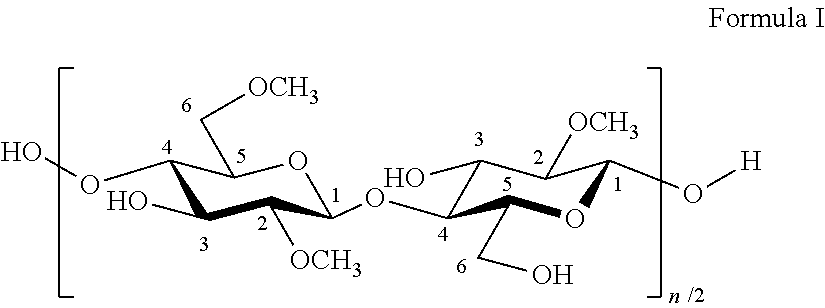Melt-extruded composition comprising a cellulose ether
a technology of cellulose ether and composition, which is applied in the direction of powder delivery, organic active ingredients, pill delivery, etc., can solve the problems of complex preparation of dosage form, difficult commercially available hydroxypropyl methylcelluloses. not easy to form solid amorphous dispersions with active ingredients, etc., to achieve the effect of reducing the degradation or decomposition of active ingredients and other components, easy to shap
- Summary
- Abstract
- Description
- Claims
- Application Information
AI Technical Summary
Benefits of technology
Problems solved by technology
Method used
Image
Examples
example 1
[0091]Hydroxypropyl methylcellulose (HPMC) was produced according to the following procedure. Finely ground wood cellulose pulp was loaded into a jacketed, agitated reactor. The reactor was evacuated and purged with nitrogen to remove oxygen and then evacuated again. The reaction was carried out in two stages. In the first stage a 50 weight percent aqueous solution of sodium hydroxide was sprayed onto the cellulose in an amount of 3.0 mole of sodium hydroxide per mole of anhydroglucose units in the cellulose and the temperature was adjusted to 40° C. After stiffing the mixture of aqueous sodium hydroxide solution and cellulose for about 30 minutes at 40° C., 1.5 mole of dimethyl ether, 5.0 mole of methyl chloride and 1.6 mole of propylene oxide per mole of anhydroglucose units were added to the reactor. The contents of the reactor were then heated in 60 min to 80° C. After having reached 80° C., the first stage reaction was allowed to proceed for 25 min
[0092]Then the reaction was co...
example 2
[0095]Example 1 was repeated, except that the amount of propylene oxide added to the reaction mixture was 1.0 mole of propylene oxide per mole of anhydroglucose units.
[0096]The obtained powder was partially depolymerized in a known manner by heating the powderous samples with up to 3.0 g gaseous hydrogen chloride per kg of powder at a temperature of at most 85° C. until the desired viscosity was achieved. The partially depolymerized hydroxypropyl methylcellulose was neutralized with sodium bicarbonate.
PUM
| Property | Measurement | Unit |
|---|---|---|
| thickness | aaaaa | aaaaa |
| thickness | aaaaa | aaaaa |
| decomposition temperature | aaaaa | aaaaa |
Abstract
Description
Claims
Application Information
 Login to View More
Login to View More - R&D
- Intellectual Property
- Life Sciences
- Materials
- Tech Scout
- Unparalleled Data Quality
- Higher Quality Content
- 60% Fewer Hallucinations
Browse by: Latest US Patents, China's latest patents, Technical Efficacy Thesaurus, Application Domain, Technology Topic, Popular Technical Reports.
© 2025 PatSnap. All rights reserved.Legal|Privacy policy|Modern Slavery Act Transparency Statement|Sitemap|About US| Contact US: help@patsnap.com


